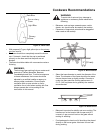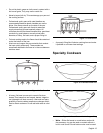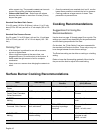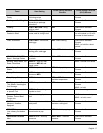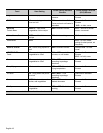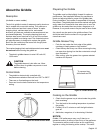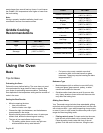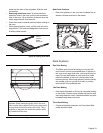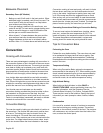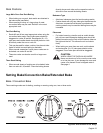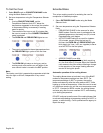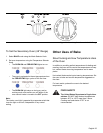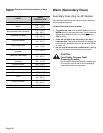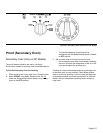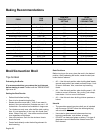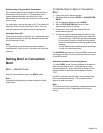English 22
Bakeware Placement
Secondary Oven (48" Models)
• Baking on rack #3 will result in the best product. When
additional height is needed, rack #2 may be used. The
use of rack #2 with pies will result in a crisp bottom
crust without over baking the top.
• If two rack baking is desired in this small oven, use
racks #2 and #5. For best results, stagger baking pans
front to rear with the pan on rack #2 toward the rear
and the pan on rack #5 toward the front.
• Allow at least 1" of space between the pans and the
oven walls so heat can circulate around each pan.
• Stagger bakeware so that one is not directly above
another. Allow 1-1/2 inches above and below each pan.
Convection
Cooking with Convection
There are many advantages to cooking with convection. In
the convection system, a fan in the back of the oven moves
heated air evenly around the oven. The moving air provides
even heat so foods can be placed on any rack level with
consistent results. Multiple racks of foods can be cooked or
large quantities of foods can be cooked at the same time.
Foods will cook thoroughly without having to rotate pans.
Low, shallow bake ware should be used with convection
cooking. This allows the heated air to circulate around the
food. Pans with high sides or pans that are covered are not
suitable for convection cooking because high sides or lids
prohibit the warm air from circulating around the food.
Your favorite pans and cookware can be used for
convection cooking provided they have low sides to allow
the heated air to circulate around the food. Any food
cooked uncovered will brown evenly and form a nice crust.
Foods in covered dishes (casseroles, pot roast) or delicate
custards do not benefit from convection cooking.
Convection Baking
Time can be saved by baking an entire batch of cookies at
the same time. The cookies will bake evenly and be done
all at once. The baking time may be shorter due to the
warm circulating air. For small items such as cookies,
check to see if they are done one to two minutes before the
recipe time. For larger baked items such as cakes, check
five to six minutes before the time indicated on the recipe.
Convection cooking of meat and poultry will result in foods
that are brown and crispy on the outside and moist and
juicy on the inside. Large meat or poultry items may cook
up to 30 minutes less than the suggested time so check
them so they will not be over baked. A meat thermometer
or an instant read thermometer will provide more accurate
results than the “minute per pound” method. The larger the
piece of meat or poultry, the more time you will save.
Converting Conventional Baking to Convection Baking
To convert most recipes for baked items (cookies, cakes,
pies, etc.); reduce the oven temperature by 25°F. For
meats and poultry, the temperature should not be reduced.
The same temperature recommended in recipes and
cooking charts for meats and poultry should be used.
Tips for Convection Bake
Preheating the Oven
Preheat the oven before baking. The oven does not need
to be preheated for large pieces of meat or poultry. See
your recipe for preheating recommendation. Preheating
time depends on the temperature setting and the number of
racks in the oven.
Temperature Setting
When using Convection Bake, reduce the temperature
recommended in the recipe by 25°F. When roasting meats,
check internal temperature prior to time recommended by
recipe to prevent over cooking. When roasting meats in
convection mode, do not reduce temperature setting.
High Altitude Baking
When baking at high altitudes, in either BAKE or
CONVECTION BAKE, recipes and baking times vary. For
accurate information, write the Extension Service,
Colorado State University, Fort Collins, Colorado 80521.
There may be a cost for the bulletins. Specify the type of
information you want (example: cakes, cookies, breads,
etc.).
Condensation
It is normal for a certain amount of moisture to evaporate
from the food during any cooking process. The amount
depends on the moisture content of the food. The moisture
will condense on any surface cooler than the inside of the
oven, such as the control panel.



